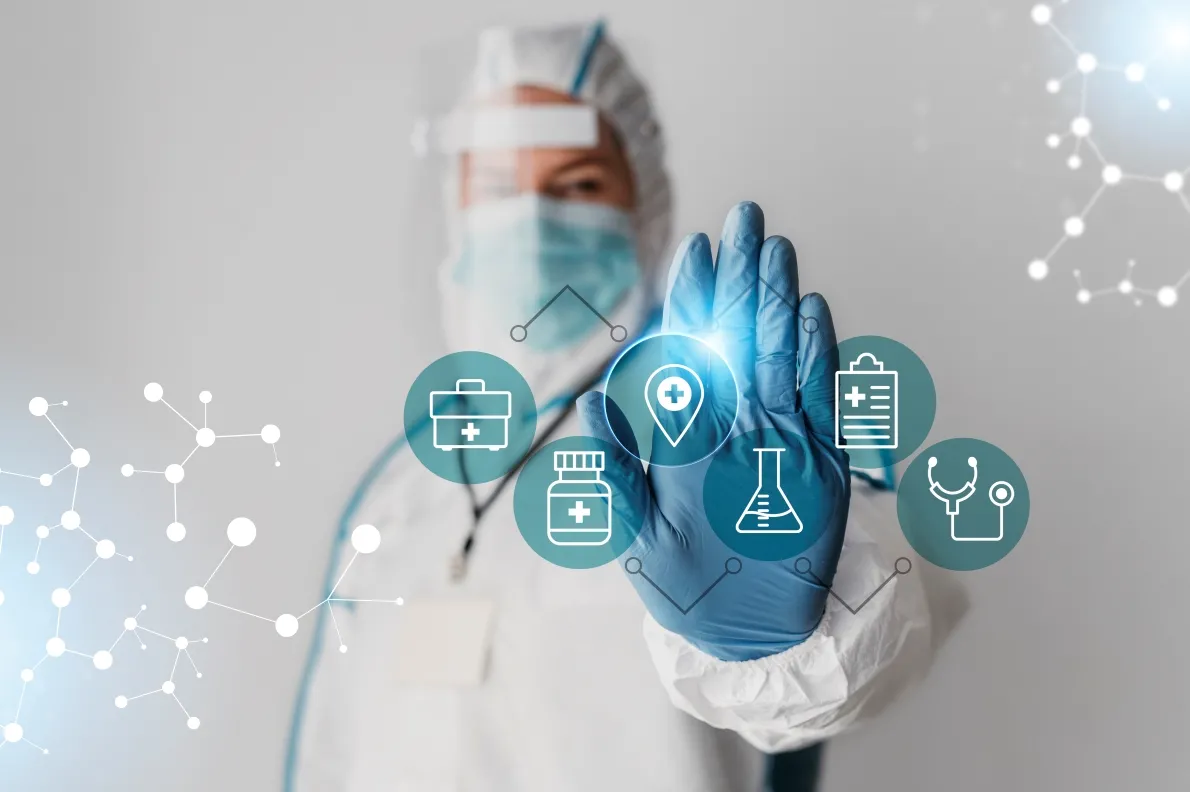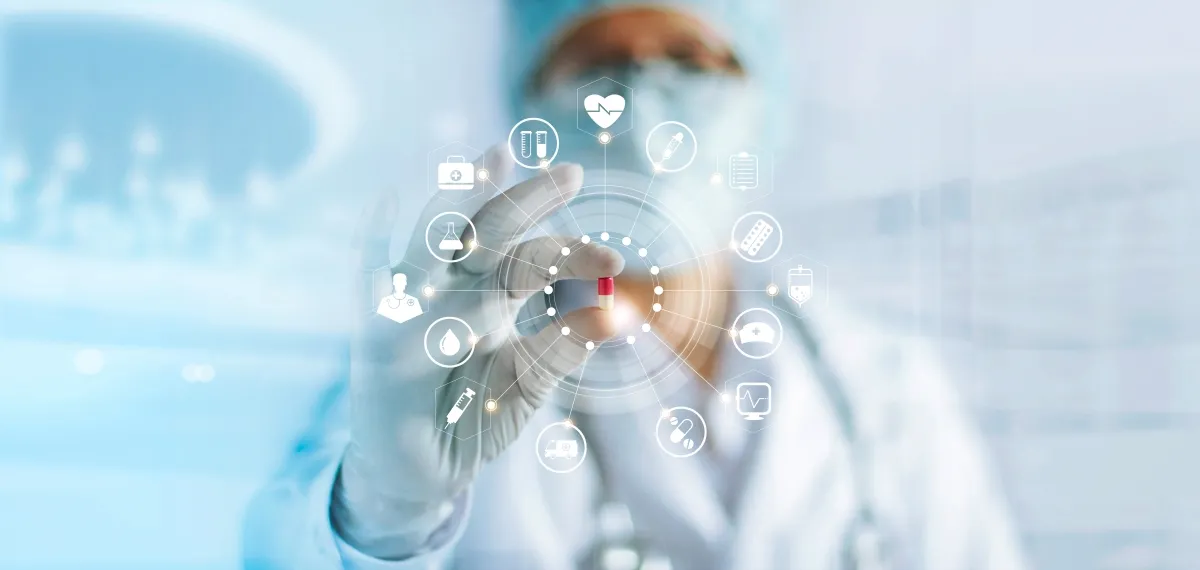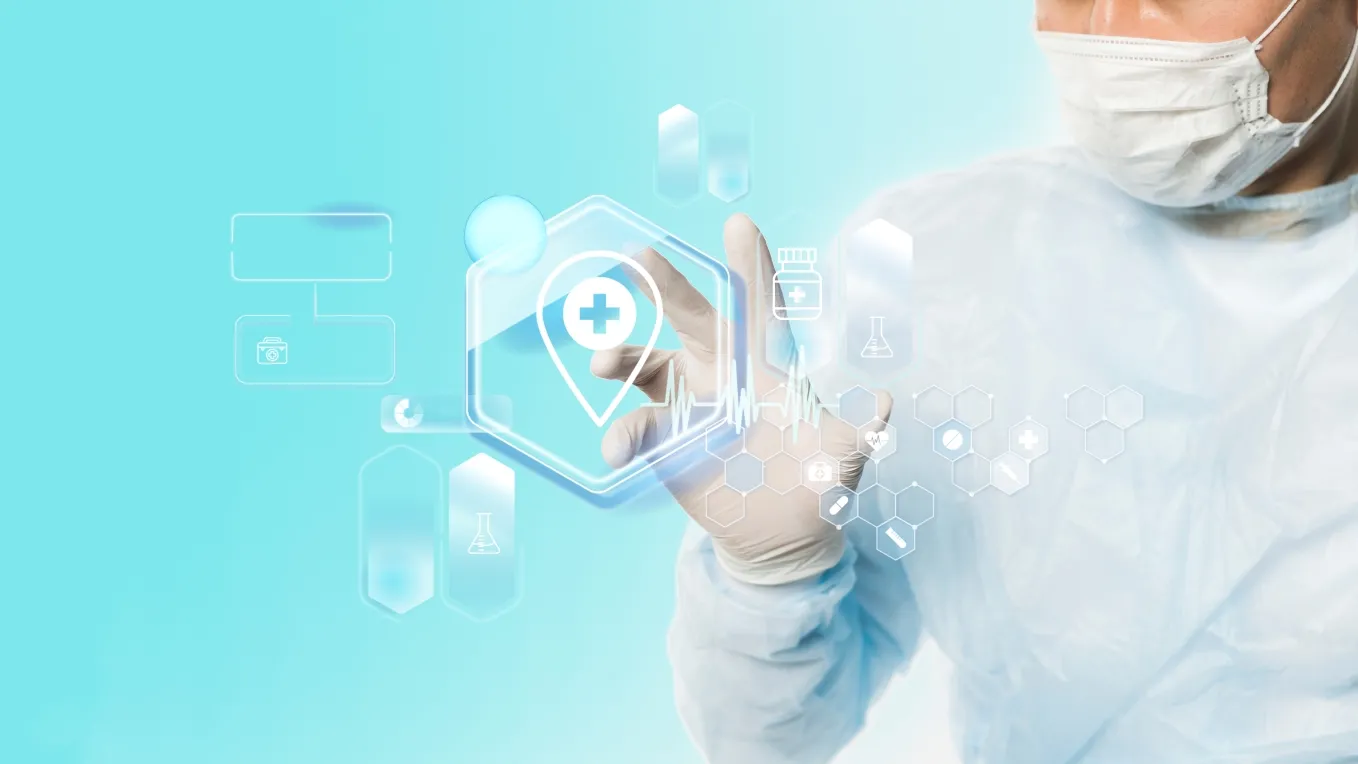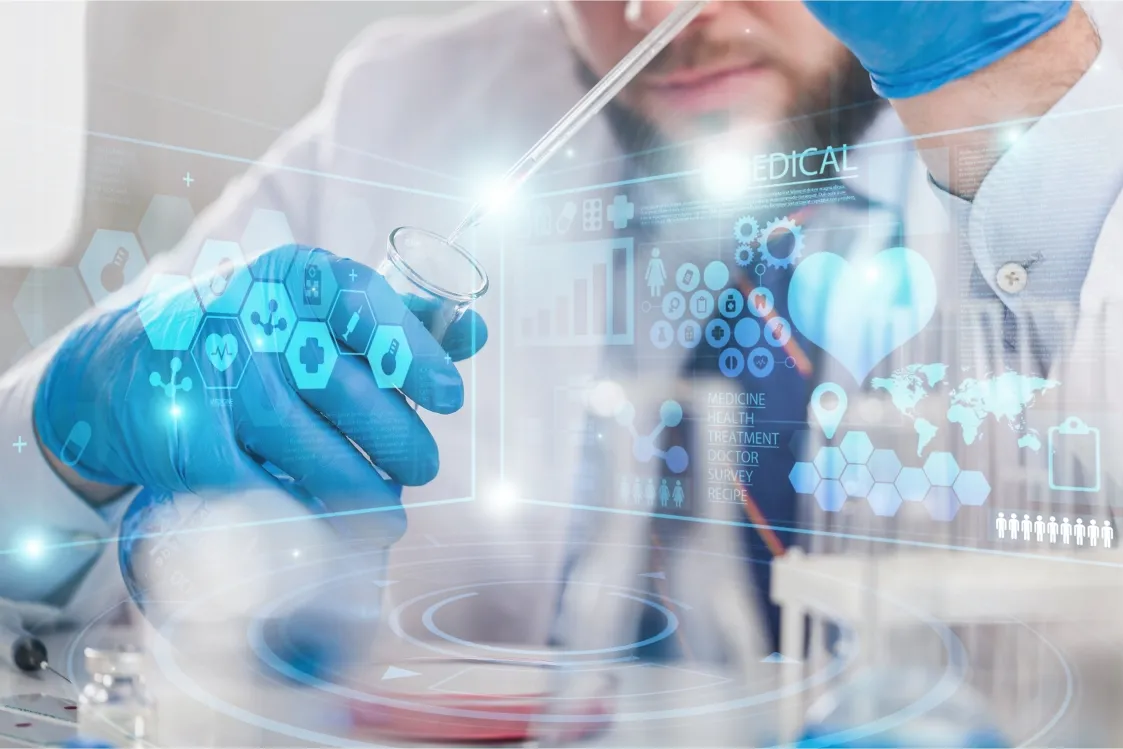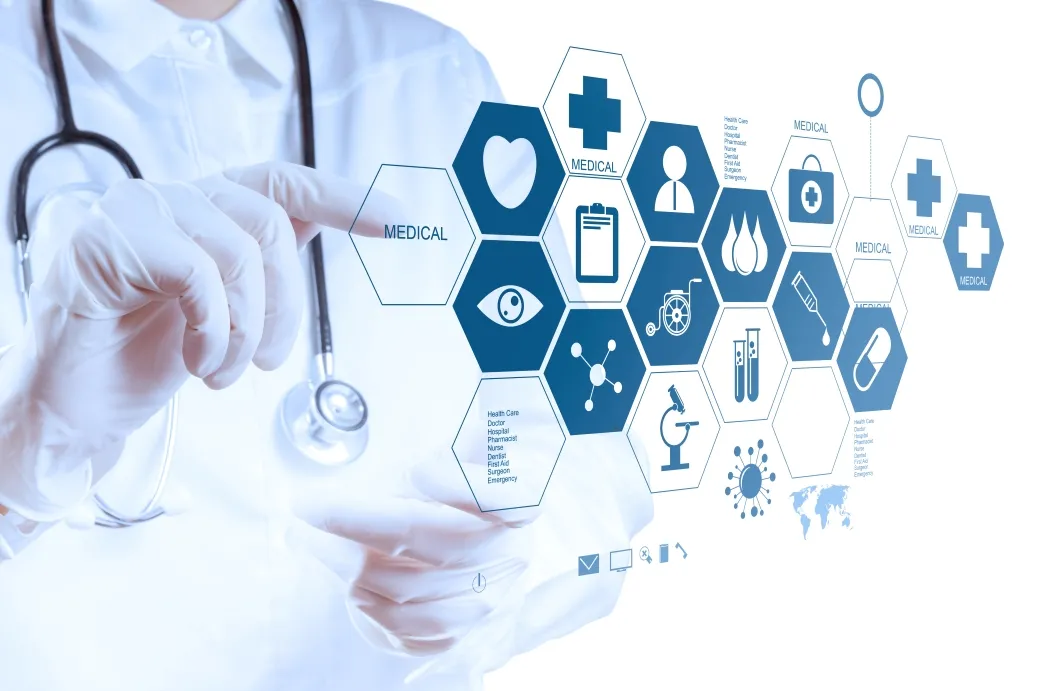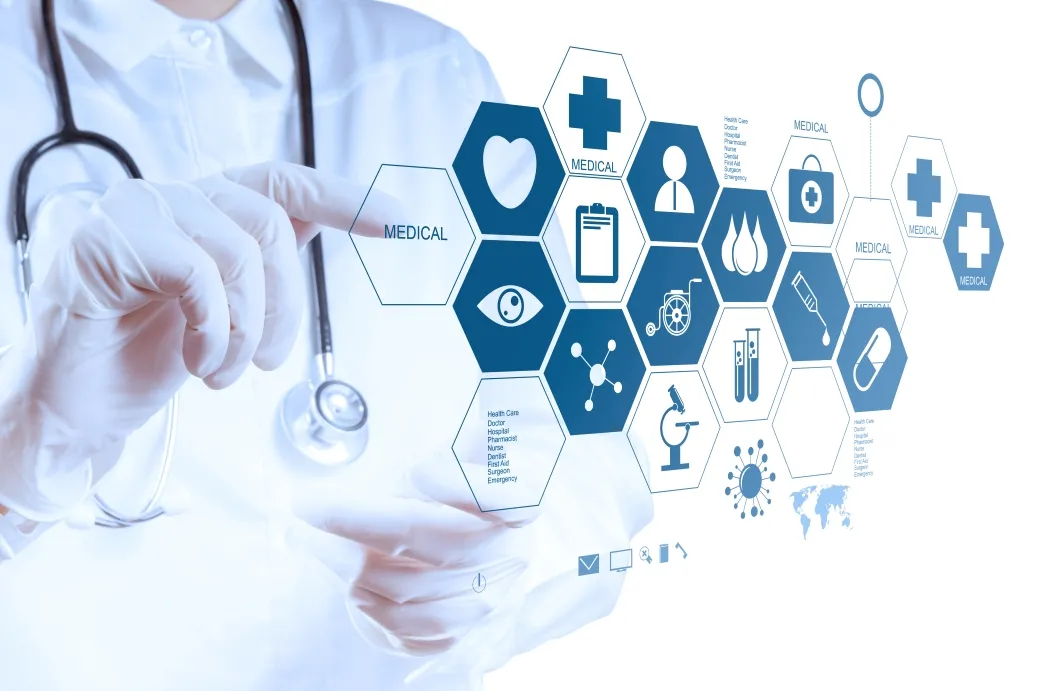Life science IT plays a crucial role in life sciences by providing sophisticated tools and solutions to manage, analyze, and interpret complex biological data. Life science IT solutions are designed to streamline various processes within the life sciences domain, including research, drug discovery, clinical trials, and healthcare management. Life science IT software typically includes applications for data management, analysis, and visualization, facilitating the collection, storage, and interpretation of complex biological and clinical data. Life science IT solutions enable researchers to conduct experiments, analyze results, and make informed decisions in areas such as drug discovery, genomics, proteomics, and personalized medicine. Additionally, life science IT software often incorporates features for regulatory compliance, quality control, and collaboration, ensuring that organizations adhere to industry standards and best practices while fostering teamwork and knowledge sharing among multidisciplinary teams.
The life sciences IT market size in expected to grow significantly, owing to high demand for advance analytical tool to analyze and manage large data generated in the healthcare sector, rise in adoption of the life science IT technology in the drug discovery and development, and growing trend towards digitalization of the healthcare system. According to life sciences IT market forecast, rise in demand for advanced analytical tools is expected to act as a significant driver for the growth of the life sciences IT market. The exponential increase in the volume of data generated within healthcare, fueled by electronic health records, genomic information, and real-time patient monitoring systems, has resulted in increase in demand for sophisticated analytical solutions for efficient analysis and management. For instance, according to a 2023 report by the National Library of Medicine, over 80% of digital data in healthcare is available as unstructured data, requiring new forms of data processing and standardizing that prove challenging to health researchers.
This report is a detailed and comprehensive analysis for global Life Sciences IT market. Both quantitative and qualitative analyses are presented by company, by region & country, by Type and by Application. As the market is constantly changing, this report explores the competition, supply and demand trends, as well as key factors that contribute to its changing demands across many markets. Company profiles and product examples of selected competitors, along with market share estimates of some of the selected leaders for the year 2024, are provided.
Key Features:
Global Life Sciences IT market size and forecasts, in consumption value ($ Million), 2019-2030
Global Life Sciences IT market size and forecasts by region and country, in consumption value ($ Million), 2019-2030
Global Life Sciences IT market size and forecasts, by Type and by Application, in consumption value ($ Million), 2019-2030
Global Life Sciences IT market shares of main players, in revenue ($ Million), 2019-2024
The Primary Objectives in This Report Are:
To determine the size of the total market opportunity of global and key countries
To assess the growth potential for Life Sciences IT
To forecast future growth in each product and end-use market
To assess competitive factors affecting the marketplace
This report profiles key players in the global Life Sciences IT market based on the following parameters - company overview, revenue, gross margin, product portfolio, geographical presence, and key developments. This report also provides key insights about market drivers, restraints, opportunities, new product launches or approvals.
Key Market Players
Thermo Fisher Scientific Inc
Oracle Corporation
Revvity, Inc
Clario
Illumina, Inc
Qiagen NV
Agilent Technologies, Inc
IBM Corporation
Genedata AG
DNAnexus, Inc
Segmentation By Type
Software
Services
Segmentation By Application
Pharmaceutical and Biotechnology Companies
Contract Research and Development Organizations
Others
Segmentation By Region
North America (United States, Canada and Mexico)
Europe (Germany, France, UK, Russia, Italy and Rest of Europe)
Asia-Pacific (China, Japan, South Korea, India, Southeast Asia and Rest of Asia-Pacific)
South America (Brazil, Rest of South America)
Middle East & Africa (Turkey, Saudi Arabia, UAE, Rest of Middle East & Africa)
Market SWOT Analysis
What are the strengths of the Life Sciences IT Market in 2025?
The Life Sciences IT Market in 2025 benefits from significant technological advancements, such as AI and cloud computing, which enhance data analysis and patient care. Strong demand for personalized medicine and improved healthcare outcomes drives innovation. Increased healthcare digitalization and rising adoption of electronic health records (EHR) further fuel growth.
What are the weaknesses in the Life Sciences IT Market in 2025?
The Life Sciences IT Market faces challenges related to data privacy concerns and regulatory compliance. The complexity of integrating new technologies with existing infrastructure can slow down implementation. Additionally, high costs for upgrading systems can be a barrier for smaller healthcare providers and research institutions.
What are the opportunities in the Life Sciences IT Market in 2025?
Opportunities exist in the growing demand for advanced data analytics, precision medicine, and wearable healthcare devices. Expanding global healthcare systems and increasing investments in health tech innovation present opportunities. There's also potential for partnerships between tech companies and healthcare providers to improve patient outcomes and streamline operations.
What are the threats in the Life Sciences IT Market in 2025?
Threats include cybersecurity risks as digital health solutions become more widespread, putting sensitive patient data at risk. There is also increasing competition among tech companies, which may lead to market fragmentation. Additionally, the ongoing complexity of healthcare regulations and potential delays in government approvals could hinder market growth.
Market PESTEL Analysis
What are the political factors influencing the Life Sciences IT Market in 2025?
Government policies supporting digital health innovation, along with funding for healthcare IT infrastructure, will continue to drive market growth. However, complex regulations related to healthcare data privacy, such as HIPAA in the U.S. or GDPR in Europe, can create compliance challenges for companies. Political stability and government incentives for healthcare technology adoption play a key role in shaping market dynamics.
What are the economic factors affecting the Life Sciences IT Market in 2025?
Economic factors include healthcare spending, which is expected to rise globally, driving demand for advanced IT solutions. Budget constraints in some regions may limit investments in IT upgrades for healthcare organizations. Additionally, the increasing cost-effectiveness of cloud computing and AI technologies presents opportunities for cost savings, particularly for smaller players in the market.
What are the social factors influencing the Life Sciences IT Market in 2025?
The growing awareness of health and wellness among consumers is pushing for more personalized healthcare solutions, boosting demand for advanced IT systems. The shift toward remote healthcare services, telemedicine, and wearable health tech is transforming patient expectations and driving innovations in digital health. Demographic changes, such as aging populations, also create a need for more efficient healthcare management solutions.
What are the technological factors impacting the Life Sciences IT Market in 2025?
The rapid evolution of technologies such as AI, machine learning, big data analytics, and cloud computing is reshaping the Life Sciences IT landscape. These advancements offer new capabilities for data management, predictive analytics, and personalized treatment. However, the integration of new technologies with legacy systems remains a challenge for many healthcare organizations.
What are the environmental factors affecting the Life Sciences IT Market in 2025?
The growing emphasis on sustainability and environmental responsibility in healthcare may influence the development of energy-efficient IT solutions. The increasing use of cloud-based infrastructure can help reduce the environmental impact of traditional data storage methods. Additionally, the need for eco-friendly manufacturing processes in the development of healthcare devices and IT systems is likely to grow.
What are the legal factors impacting the Life Sciences IT Market in 2025?
Legal factors such as data protection laws, intellectual property regulations, and healthcare compliance requirements are critical to the market’s development. Strict regulations surrounding patient data security and privacy, as well as liability concerns related to AI-based diagnoses and treatment plans, will continue to shape industry practices. Keeping up with evolving legal frameworks across different regions is essential for companies operating in the space.
Market SIPOC Analysis
Who are the suppliers in the Life Sciences IT Market in 2025?
Suppliers include technology companies that provide IT solutions, such as cloud platforms, AI tools, and data analytics software. Hardware providers who supply servers, storage devices, and other medical technology equipment also play a role. Additionally, healthcare service providers, research institutions, and software developers contributing to health-related IT systems are key suppliers.
What are the inputs in the Life Sciences IT Market in 2025?
Inputs consist of raw data from healthcare systems, patient records, clinical trial data, and research findings. Technological components like software platforms, cloud services, and AI algorithms are also crucial. Skilled personnel, including IT professionals, data scientists, and healthcare experts, are necessary to process and analyze this data.
What are the processes in the Life Sciences IT Market in 2025?
Key processes involve data collection, storage, and management through electronic health records and cloud-based platforms. Advanced analytics, AI-based decision-making tools, and data integration are used to derive insights. Software development, system integration, and user training are also critical for ensuring that healthcare organizations can effectively use IT solutions.
Who are the customers in the Life Sciences IT Market in 2025?
Customers include healthcare providers like hospitals, clinics, and research institutions looking for IT solutions to improve patient care, streamline operations, and advance research. Pharmaceutical companies and life sciences firms seeking data-driven insights for drug development are also key customers. Additionally, end-users, such as patients, benefit from personalized healthcare solutions powered by IT innovations.
What are the outputs in the Life Sciences IT Market in 2025?
Outputs include advanced healthcare IT systems, data-driven tools for personalized medicine, predictive analytics, and improved patient management solutions. New software applications and AI models for clinical trials, diagnostic support, and treatment optimization are also outputs. Furthermore, insights derived from big data can guide policy decisions, research, and innovation in healthcare.
Market Porter's Five Forces
What is the threat of new entrants in the Life Sciences IT Market in 2025?
The threat of new entrants is moderate to high due to the rapid technological advancements in AI, cloud computing, and big data analytics. While the capital investment and regulatory compliance requirements can be barriers, the increasing demand for digital health solutions and relatively low entry costs in software development create opportunities for new players.
What is the bargaining power of suppliers in the Life Sciences IT Market in 2025?
The bargaining power of suppliers is moderate. While there are numerous technology providers and hardware manufacturers in the market, companies offering specialized solutions, such as AI algorithms or cloud-based infrastructure, have more leverage. However, the growing number of suppliers in healthcare IT solutions reduces the power of individual suppliers.
What is the bargaining power of buyers in the Life Sciences IT Market in 2025?
The bargaining power of buyers is high, particularly for large healthcare organizations, research institutions, and pharmaceutical companies. These buyers can negotiate better pricing and terms due to their scale and purchasing power. As the market becomes more competitive, buyers have a wider range of options, enhancing their ability to demand customized solutions.
What is the threat of substitute products or services in the Life Sciences IT Market in 2025?
The threat of substitutes is moderate. While alternatives like traditional healthcare management practices or manual research methods still exist, the increasing effectiveness and efficiency of IT solutions in delivering personalized care, data analytics, and AI-driven insights make these substitutes less appealing. However, the development of new, emerging technologies could potentially create substitutes in the future.
What is the intensity of competitive rivalry in the Life Sciences IT Market in 2025?
The intensity of competitive rivalry is high. The market is becoming increasingly crowded with both established tech giants and emerging startups vying for market share. Companies are focused on innovation, pricing strategies, and providing specialized solutions to differentiate themselves. This competition drives rapid technological advancements but also puts pressure on profitability.
Market Upstream Analysis
What are the key suppliers in the upstream of the Life Sciences IT Market in 2025?
Key suppliers include technology firms providing software, cloud infrastructure, AI tools, and machine learning algorithms. Hardware providers for computing resources such as servers, storage systems, and medical devices also play a critical role. Additionally, research institutions and data management firms that offer specialized expertise and data solutions contribute significantly to the upstream.
What are the essential resources required in the upstream of the Life Sciences IT Market in 2025?
Essential resources include advanced technological infrastructure, such as high-performance computing systems, data storage solutions, and networking capabilities. Skilled professionals, such as software developers, data scientists, and healthcare experts, are crucial for innovation and system integration. Furthermore, large, high-quality datasets, including clinical and patient data, are vital for training AI models and developing new IT solutions.
What are the challenges faced in the upstream of the Life Sciences IT Market in 2025?
Challenges include the complexity of integrating new technologies with existing healthcare IT systems. Regulatory hurdles related to data privacy, security, and compliance with global standards also pose obstacles. Additionally, the cost of acquiring high-quality resources, maintaining cutting-edge infrastructure, and training personnel can be a barrier, especially for smaller players.
What are the opportunities in the upstream of the Life Sciences IT Market in 2025?
Opportunities in the upstream include the growing demand for innovative AI, machine learning, and big data solutions in healthcare. The expansion of cloud computing offers potential for scalable, cost-effective infrastructure. Collaboration with healthcare providers to develop tailored IT solutions for specific needs, such as personalized medicine or precision diagnostics, is a promising avenue for growth.
What are the trends in the upstream of the Life Sciences IT Market in 2025?
Trends include increasing investment in cloud-based solutions, which provide scalability and flexibility for healthcare providers. The adoption of AI and machine learning for data analysis, predictive modeling, and diagnostic tools is growing rapidly. Additionally, there is a focus on data interoperability to facilitate seamless exchange between different healthcare systems, enhancing the efficiency of IT solutions.
Market Midstream Analysis
What are the key players in the midstream of the Life Sciences IT Market in 2025?
Key players in the midstream include system integrators, software developers, and third-party vendors that provide specialized IT solutions. These companies focus on tailoring IT systems to meet the unique needs of healthcare providers, pharmaceutical companies, and research institutions. Additionally, service providers offering cloud-based solutions and data analytics are vital players in this segment.
What are the primary processes in the midstream of the Life Sciences IT Market in 2025?
Primary processes include the customization and integration of software applications, such as electronic health records (EHR) systems and AI-driven diagnostic tools, to meet specific healthcare needs. Data management and analysis processes are essential for providing actionable insights through big data and machine learning models. Additionally, ensuring system interoperability and compliance with regulations are key processes in the midstream.
What challenges are faced in the midstream of the Life Sciences IT Market in 2025?
Challenges in the midstream include integrating new IT systems with legacy infrastructures in healthcare organizations. Additionally, ensuring compliance with diverse and evolving data privacy regulations across regions can complicate system deployments. There is also the challenge of maintaining high standards of data security while facilitating real-time access to healthcare data for various stakeholders.
What opportunities exist in the midstream of the Life Sciences IT Market in 2025?
Opportunities lie in the growing need for advanced data analytics and AI solutions for personalized medicine, predictive diagnostics, and clinical trials. The shift toward value-based care presents an opportunity for IT solutions that optimize patient outcomes and streamline healthcare delivery. Additionally, offering scalable, cloud-based services that meet the needs of diverse healthcare settings creates significant market potential.
What are the trends in the midstream of the Life Sciences IT Market in 2025?
Trends include the rise of AI and machine learning for clinical decision support and predictive modeling in patient care. Cloud adoption continues to grow as healthcare organizations seek flexible, cost-effective solutions. There is also a focus on ensuring the interoperability of IT systems across healthcare providers, enabling seamless data exchange and improving patient outcomes. Additionally, the growing emphasis on cybersecurity is shaping the development of secure and compliant IT systems in healthcare.
Market Downstream Analysis
What are the key customers in the downstream of the Life Sciences IT Market in 2025?
Key customers include healthcare providers such as hospitals, clinics, and physicians who rely on IT solutions for patient management, diagnostics, and treatment planning. Pharmaceutical companies and biotech firms also use these technologies for drug development, clinical trials, and regulatory compliance. Additionally, research institutions and public health organizations are major customers seeking advanced data analytics for epidemiology and health outcomes.
What are the main deliverables in the downstream of the Life Sciences IT Market in 2025?
Main deliverables include integrated healthcare IT systems such as electronic health records (EHR), laboratory information management systems (LIMS), and telemedicine platforms. Additionally, AI-driven tools for diagnostic support, predictive analytics, and personalized treatment plans are key deliverables. Cloud-based solutions that enable secure data storage and real-time access are also important products in the downstream.
What challenges are faced in the downstream of the Life Sciences IT Market in 2025?
Challenges include resistance to adopting new technologies from healthcare providers due to concerns over cost, training, and disruption to existing workflows. Ensuring the usability and effectiveness of IT solutions in diverse healthcare settings can be complex. Furthermore, maintaining robust data security and compliance with privacy regulations while providing seamless access to critical information is a persistent challenge.
What opportunities exist in the downstream of the Life Sciences IT Market in 2025?
Opportunities exist in the growing demand for telemedicine, remote monitoring, and personalized healthcare, especially post-pandemic. The continued shift toward value-based care creates demand for IT solutions that improve patient outcomes and reduce costs. There are also significant opportunities in providing AI-driven tools for precision medicine, predictive analytics, and healthcare automation.
What trends are shaping the downstream of the Life Sciences IT Market in 2025?
Trends include the increasing adoption of AI and machine learning to enhance clinical decision-making and streamline healthcare operations. Cloud computing continues to be a dominant trend, providing scalable and cost-effective solutions for healthcare organizations. Additionally, there is a focus on patient-centric solutions, including telemedicine, wearable health devices, and personalized care platforms that empower patients to manage their health more proactively.
Chapter 1, to describe Life Sciences IT product scope, market overview, market estimation caveats and base year.
Chapter 2, to profile the top players of Life Sciences IT, with revenue, gross margin, and global market share of Life Sciences IT from 2019 to 2024.
Chapter 3, the Life Sciences IT competitive situation, revenue, and global market share of top players are analyzed emphatically by landscape contrast.
Chapter 4 and 5, to segment the market size by Type and by Application, with consumption value and growth rate by Type, by Application, from 2019 to 2030.
Chapter 6, 7, 8, 9, and 10, to break the market size data at the country level, with revenue and market share for key countries in the world, from 2019 to 2024.and Life Sciences IT market forecast, by regions, by Type and by Application, with consumption value, from 2024 to 2030.
Chapter 11, market dynamics, drivers, restraints, trends, Porters Five Forces analysis.
Chapter 12, the key raw materials and key suppliers, and industry chain of Life Sciences IT.
Chapter 13, to describe Life Sciences IT research findings and conclusion.
1 Market Overview
1.1 Product Overview and Scope
1.2 Market Estimation Caveats and Base Year
1.3 Classification of Life Sciences IT by Type
1.3.1 Overview: Global Life Sciences IT Market Size by Type: 2019 Versus 2023 Versus 2030
1.3.2 Global Life Sciences IT Consumption Value Market Share by Type in 2023
1.3.3 Software
1.3.4 Services
1.4 Global Life Sciences IT Market by Application
1.4.1 Overview: Global Life Sciences IT Market Size by Application: 2019 Versus 2023 Versus 2030
1.4.2 Pharmaceutical and Biotechnology Companies
1.4.3 Contract Research and Development Organizations
1.4.4 Others
1.5 Global Life Sciences IT Market Size & Forecast
1.6 Global Life Sciences IT Market Size and Forecast by Region
1.6.1 Global Life Sciences IT Market Size by Region: 2019 VS 2023 VS 2030
1.6.2 Global Life Sciences IT Market Size by Region, (2019-2030)
1.6.3 North America Life Sciences IT Market Size and Prospect (2019-2030)
1.6.4 Europe Life Sciences IT Market Size and Prospect (2019-2030)
1.6.5 Asia-Pacific Life Sciences IT Market Size and Prospect (2019-2030)
1.6.6 South America Life Sciences IT Market Size and Prospect (2019-2030)
1.6.7 Middle East & Africa Life Sciences IT Market Size and Prospect (2019-2030)
2 Company Profiles
2.1 Thermo Fisher Scientific Inc
2.1.1 Thermo Fisher Scientific Inc Details
2.1.2 Thermo Fisher Scientific Inc Major Business
2.1.3 Thermo Fisher Scientific Inc Life Sciences IT Product and Solutions
2.1.4 Thermo Fisher Scientific Inc Life Sciences IT Revenue, Gross Margin and Market Share (2019-2024)
2.1.5 Thermo Fisher Scientific Inc Recent Developments and Future Plans
2.2 Oracle Corporation
2.2.1 Oracle Corporation Details
2.2.2 Oracle Corporation Major Business
2.2.3 Oracle Corporation Life Sciences IT Product and Solutions
2.2.4 Oracle Corporation Life Sciences IT Revenue, Gross Margin and Market Share (2019-2024)
2.2.5 Oracle Corporation Recent Developments and Future Plans
2.3 Revvity, Inc
2.3.1 Revvity, Inc Details
2.3.2 Revvity, Inc Major Business
2.3.3 Revvity, Inc Life Sciences IT Product and Solutions
2.3.4 Revvity, Inc Life Sciences IT Revenue, Gross Margin and Market Share (2019-2024)
2.3.5 Revvity, Inc Recent Developments and Future Plans
2.4 Clario
2.4.1 Clario Details
2.4.2 Clario Major Business
2.4.3 Clario Life Sciences IT Product and Solutions
2.4.4 Clario Life Sciences IT Revenue, Gross Margin and Market Share (2019-2024)
2.4.5 Clario Recent Developments and Future Plans
2.5 Illumina, Inc
2.5.1 Illumina, Inc Details
2.5.2 Illumina, Inc Major Business
2.5.3 Illumina, Inc Life Sciences IT Product and Solutions
2.5.4 Illumina, Inc Life Sciences IT Revenue, Gross Margin and Market Share (2019-2024)
2.5.5 Illumina, Inc Recent Developments and Future Plans
2.6 Qiagen NV
2.6.1 Qiagen NV Details
2.6.2 Qiagen NV Major Business
2.6.3 Qiagen NV Life Sciences IT Product and Solutions
2.6.4 Qiagen NV Life Sciences IT Revenue, Gross Margin and Market Share (2019-2024)
2.6.5 Qiagen NV Recent Developments and Future Plans
2.7 Agilent Technologies, Inc
2.7.1 Agilent Technologies, Inc Details
2.7.2 Agilent Technologies, Inc Major Business
2.7.3 Agilent Technologies, Inc Life Sciences IT Product and Solutions
2.7.4 Agilent Technologies, Inc Life Sciences IT Revenue, Gross Margin and Market Share (2019-2024)
2.7.5 Agilent Technologies, Inc Recent Developments and Future Plans
2.8 IBM Corporation
2.8.1 IBM Corporation Details
2.8.2 IBM Corporation Major Business
2.8.3 IBM Corporation Life Sciences IT Product and Solutions
2.8.4 IBM Corporation Life Sciences IT Revenue, Gross Margin and Market Share (2019-2024)
2.8.5 IBM Corporation Recent Developments and Future Plans
2.9 Genedata AG
2.9.1 Genedata AG Details
2.9.2 Genedata AG Major Business
2.9.3 Genedata AG Life Sciences IT Product and Solutions
2.9.4 Genedata AG Life Sciences IT Revenue, Gross Margin and Market Share (2019-2024)
2.9.5 Genedata AG Recent Developments and Future Plans
2.10 DNAnexus, Inc
2.10.1 DNAnexus, Inc Details
2.10.2 DNAnexus, Inc Major Business
2.10.3 DNAnexus, Inc Life Sciences IT Product and Solutions
2.10.4 DNAnexus, Inc Life Sciences IT Revenue, Gross Margin and Market Share (2019-2024)
2.10.5 DNAnexus, Inc Recent Developments and Future Plans
3 Market Competition, by Players
3.1 Global Life Sciences IT Revenue and Share by Players (2019-2024)
3.2 Market Share Analysis (2023)
3.2.1 Market Share of Life Sciences IT by Company Revenue
3.2.2 Top 3 Life Sciences IT Players Market Share in 2023
3.2.3 Top 6 Life Sciences IT Players Market Share in 2023
3.3 Life Sciences IT Market: Overall Company Footprint Analysis
3.3.1 Life Sciences IT Market: Region Footprint
3.3.2 Life Sciences IT Market: Company Product Type Footprint
3.3.3 Life Sciences IT Market: Company Product Application Footprint
3.4 New Market Entrants and Barriers to Market Entry
3.5 Mergers, Acquisition, Agreements, and Collaborations
4 Market Size Segment by Type
4.1 Global Life Sciences IT Consumption Value and Market Share by Type (2019-2024)
4.2 Global Life Sciences IT Market Forecast by Type (2025-2030)
5 Market Size Segment by Application
5.1 Global Life Sciences IT Consumption Value Market Share by Application (2019-2024)
5.2 Global Life Sciences IT Market Forecast by Application (2025-2030)
6 North America
6.1 North America Life Sciences IT Consumption Value by Type (2019-2030)
6.2 North America Life Sciences IT Market Size by Application (2019-2030)
6.3 North America Life Sciences IT Market Size by Country
6.3.1 North America Life Sciences IT Consumption Value by Country (2019-2030)
6.3.2 United States Life Sciences IT Market Size and Forecast (2019-2030)
6.3.3 Canada Life Sciences IT Market Size and Forecast (2019-2030)
6.3.4 Mexico Life Sciences IT Market Size and Forecast (2019-2030)
7 Europe
7.1 Europe Life Sciences IT Consumption Value by Type (2019-2030)
7.2 Europe Life Sciences IT Consumption Value by Application (2019-2030)
7.3 Europe Life Sciences IT Market Size by Country
7.3.1 Europe Life Sciences IT Consumption Value by Country (2019-2030)
7.3.2 Germany Life Sciences IT Market Size and Forecast (2019-2030)
7.3.3 France Life Sciences IT Market Size and Forecast (2019-2030)
7.3.4 United Kingdom Life Sciences IT Market Size and Forecast (2019-2030)
7.3.5 Russia Life Sciences IT Market Size and Forecast (2019-2030)
7.3.6 Italy Life Sciences IT Market Size and Forecast (2019-2030)
8 Asia-Pacific
8.1 Asia-Pacific Life Sciences IT Consumption Value by Type (2019-2030)
8.2 Asia-Pacific Life Sciences IT Consumption Value by Application (2019-2030)
8.3 Asia-Pacific Life Sciences IT Market Size by Region
8.3.1 Asia-Pacific Life Sciences IT Consumption Value by Region (2019-2030)
8.3.2 China Life Sciences IT Market Size and Forecast (2019-2030)
8.3.3 Japan Life Sciences IT Market Size and Forecast (2019-2030)
8.3.4 South Korea Life Sciences IT Market Size and Forecast (2019-2030)
8.3.5 India Life Sciences IT Market Size and Forecast (2019-2030)
8.3.6 Southeast Asia Life Sciences IT Market Size and Forecast (2019-2030)
8.3.7 Australia Life Sciences IT Market Size and Forecast (2019-2030)
9 South America
9.1 South America Life Sciences IT Consumption Value by Type (2019-2030)
9.2 South America Life Sciences IT Consumption Value by Application (2019-2030)
9.3 South America Life Sciences IT Market Size by Country
9.3.1 South America Life Sciences IT Consumption Value by Country (2019-2030)
9.3.2 Brazil Life Sciences IT Market Size and Forecast (2019-2030)
9.3.3 Argentina Life Sciences IT Market Size and Forecast (2019-2030)
10 Middle East & Africa
10.1 Middle East & Africa Life Sciences IT Consumption Value by Type (2019-2030)
10.2 Middle East & Africa Life Sciences IT Consumption Value by Application (2019-2030)
10.3 Middle East & Africa Life Sciences IT Market Size by Country
10.3.1 Middle East & Africa Life Sciences IT Consumption Value by Country (2019-2030)
10.3.2 Turkey Life Sciences IT Market Size and Forecast (2019-2030)
10.3.3 Saudi Arabia Life Sciences IT Market Size and Forecast (2019-2030)
10.3.4 UAE Life Sciences IT Market Size and Forecast (2019-2030)
11 Market Dynamics
11.1 Life Sciences IT Market Drivers
11.2 Life Sciences IT Market Restraints
11.3 Life Sciences IT Trends Analysis
11.4 Porters Five Forces Analysis
11.4.1 Threat of New Entrants
11.4.2 Bargaining Power of Suppliers
11.4.3 Bargaining Power of Buyers
11.4.4 Threat of Substitutes
11.4.5 Competitive Rivalry
12 Industry Chain Analysis
12.1 Life Sciences IT Industry Chain
12.2 Life Sciences IT Upstream Analysis
12.3 Life Sciences IT Midstream Analysis
12.4 Life Sciences IT Downstream Analysis
13 Research Findings and Conclusion
14 Appendix
14.1 Methodology
14.2 Research Process and Data Source
14.3 Disclaimer
List of Tables
Table 1. Global Life Sciences IT Consumption Value by Type, (USD Million), 2019 & 2023 & 2030
Table 2. Global Life Sciences IT Consumption Value by Application, (USD Million), 2019 & 2023 & 2030
Table 3. Global Life Sciences IT Consumption Value by Region (2019-2024) & (USD Million)
Table 4. Global Life Sciences IT Consumption Value by Region (2025-2030) & (USD Million)
Table 5. Thermo Fisher Scientific Inc Company Information, Head Office, and Major Competitors
Table 6. Thermo Fisher Scientific Inc Major Business
Table 7. Thermo Fisher Scientific Inc Life Sciences IT Product and Solutions
Table 8. Thermo Fisher Scientific Inc Life Sciences IT Revenue (USD Million), Gross Margin and Market Share (2019-2024)
Table 9. Thermo Fisher Scientific Inc Recent Developments and Future Plans
Table 10. Oracle Corporation Company Information, Head Office, and Major Competitors
Table 11. Oracle Corporation Major Business
Table 12. Oracle Corporation Life Sciences IT Product and Solutions
Table 13. Oracle Corporation Life Sciences IT Revenue (USD Million), Gross Margin and Market Share (2019-2024)
Table 14. Oracle Corporation Recent Developments and Future Plans
Table 15. Revvity, Inc Company Information, Head Office, and Major Competitors
Table 16. Revvity, Inc Major Business
Table 17. Revvity, Inc Life Sciences IT Product and Solutions
Table 18. Revvity, Inc Life Sciences IT Revenue (USD Million), Gross Margin and Market Share (2019-2024)
Table 19. Clario Company Information, Head Office, and Major Competitors
Table 20. Clario Major Business
Table 21. Clario Life Sciences IT Product and Solutions
Table 22. Clario Life Sciences IT Revenue (USD Million), Gross Margin and Market Share (2019-2024)
Table 23. Clario Recent Developments and Future Plans
Table 24. Illumina, Inc Company Information, Head Office, and Major Competitors
Table 25. Illumina, Inc Major Business
Table 26. Illumina, Inc Life Sciences IT Product and Solutions
Table 27. Illumina, Inc Life Sciences IT Revenue (USD Million), Gross Margin and Market Share (2019-2024)
Table 28. Illumina, Inc Recent Developments and Future Plans
Table 29. Qiagen NV Company Information, Head Office, and Major Competitors
Table 30. Qiagen NV Major Business
Table 31. Qiagen NV Life Sciences IT Product and Solutions
Table 32. Qiagen NV Life Sciences IT Revenue (USD Million), Gross Margin and Market Share (2019-2024)
Table 33. Qiagen NV Recent Developments and Future Plans
Table 34. Agilent Technologies, Inc Company Information, Head Office, and Major Competitors
Table 35. Agilent Technologies, Inc Major Business
Table 36. Agilent Technologies, Inc Life Sciences IT Product and Solutions
Table 37. Agilent Technologies, Inc Life Sciences IT Revenue (USD Million), Gross Margin and Market Share (2019-2024)
Table 38. Agilent Technologies, Inc Recent Developments and Future Plans
Table 39. IBM Corporation Company Information, Head Office, and Major Competitors
Table 40. IBM Corporation Major Business
Table 41. IBM Corporation Life Sciences IT Product and Solutions
Table 42. IBM Corporation Life Sciences IT Revenue (USD Million), Gross Margin and Market Share (2019-2024)
Table 43. IBM Corporation Recent Developments and Future Plans
Table 44. Genedata AG Company Information, Head Office, and Major Competitors
Table 45. Genedata AG Major Business
Table 46. Genedata AG Life Sciences IT Product and Solutions
Table 47. Genedata AG Life Sciences IT Revenue (USD Million), Gross Margin and Market Share (2019-2024)
Table 48. Genedata AG Recent Developments and Future Plans
Table 49. DNAnexus, Inc Company Information, Head Office, and Major Competitors
Table 50. DNAnexus, Inc Major Business
Table 51. DNAnexus, Inc Life Sciences IT Product and Solutions
Table 52. DNAnexus, Inc Life Sciences IT Revenue (USD Million), Gross Margin and Market Share (2019-2024)
Table 53. DNAnexus, Inc Recent Developments and Future Plans
Table 54. Global Life Sciences IT Revenue (USD Million) by Players (2019-2024)
Table 55. Global Life Sciences IT Revenue Share by Players (2019-2024)
Table 56. Breakdown of Life Sciences IT by Company Type (Tier 1, Tier 2, and Tier 3)
Table 57. Market Position of Players in Life Sciences IT, (Tier 1, Tier 2, and Tier 3), Based on Revenue in 2023
Table 58. Head Office of Key Life Sciences IT Players
Table 59. Life Sciences IT Market: Company Product Type Footprint
Table 60. Life Sciences IT Market: Company Product Application Footprint
Table 61. Life Sciences IT New Market Entrants and Barriers to Market Entry
Table 62. Life Sciences IT Mergers, Acquisition, Agreements, and Collaborations
Table 63. Global Life Sciences IT Consumption Value (USD Million) by Type (2019-2024)
Table 64. Global Life Sciences IT Consumption Value Share by Type (2019-2024)
Table 65. Global Life Sciences IT Consumption Value Forecast by Type (2025-2030)
Table 66. Global Life Sciences IT Consumption Value by Application (2019-2024)
Table 67. Global Life Sciences IT Consumption Value Forecast by Application (2025-2030)
Table 68. North America Life Sciences IT Consumption Value by Type (2019-2024) & (USD Million)
Table 69. North America Life Sciences IT Consumption Value by Type (2025-2030) & (USD Million)
Table 70. North America Life Sciences IT Consumption Value by Application (2019-2024) & (USD Million)
Table 71. North America Life Sciences IT Consumption Value by Application (2025-2030) & (USD Million)
Table 72. North America Life Sciences IT Consumption Value by Country (2019-2024) & (USD Million)
Table 73. North America Life Sciences IT Consumption Value by Country (2025-2030) & (USD Million)
Table 74. Europe Life Sciences IT Consumption Value by Type (2019-2024) & (USD Million)
Table 75. Europe Life Sciences IT Consumption Value by Type (2025-2030) & (USD Million)
Table 76. Europe Life Sciences IT Consumption Value by Application (2019-2024) & (USD Million)
Table 77. Europe Life Sciences IT Consumption Value by Application (2025-2030) & (USD Million)
Table 78. Europe Life Sciences IT Consumption Value by Country (2019-2024) & (USD Million)
Table 79. Europe Life Sciences IT Consumption Value by Country (2025-2030) & (USD Million)
Table 80. Asia-Pacific Life Sciences IT Consumption Value by Type (2019-2024) & (USD Million)
Table 81. Asia-Pacific Life Sciences IT Consumption Value by Type (2025-2030) & (USD Million)
Table 82. Asia-Pacific Life Sciences IT Consumption Value by Application (2019-2024) & (USD Million)
Table 83. Asia-Pacific Life Sciences IT Consumption Value by Application (2025-2030) & (USD Million)
Table 84. Asia-Pacific Life Sciences IT Consumption Value by Region (2019-2024) & (USD Million)
Table 85. Asia-Pacific Life Sciences IT Consumption Value by Region (2025-2030) & (USD Million)
Table 86. South America Life Sciences IT Consumption Value by Type (2019-2024) & (USD Million)
Table 87. South America Life Sciences IT Consumption Value by Type (2025-2030) & (USD Million)
Table 88. South America Life Sciences IT Consumption Value by Application (2019-2024) & (USD Million)
Table 89. South America Life Sciences IT Consumption Value by Application (2025-2030) & (USD Million)
Table 90. South America Life Sciences IT Consumption Value by Country (2019-2024) & (USD Million)
Table 91. South America Life Sciences IT Consumption Value by Country (2025-2030) & (USD Million)
Table 92. Middle East & Africa Life Sciences IT Consumption Value by Type (2019-2024) & (USD Million)
Table 93. Middle East & Africa Life Sciences IT Consumption Value by Type (2025-2030) & (USD Million)
Table 94. Middle East & Africa Life Sciences IT Consumption Value by Application (2019-2024) & (USD Million)
Table 95. Middle East & Africa Life Sciences IT Consumption Value by Application (2025-2030) & (USD Million)
Table 96. Middle East & Africa Life Sciences IT Consumption Value by Country (2019-2024) & (USD Million)
Table 97. Middle East & Africa Life Sciences IT Consumption Value by Country (2025-2030) & (USD Million)
Table 98. Global Key Players of Life Sciences IT Upstream (Raw Materials)
Table 99. Global Life Sciences IT Typical Customers
List of Figures
Figure 1. Life Sciences IT Picture
Figure 2. Global Life Sciences IT Consumption Value by Type, (USD Million), 2019 & 2023 & 2030
Figure 3. Global Life Sciences IT Consumption Value Market Share by Type in 2023
Figure 4. Software
Figure 5. Services
Figure 6. Global Life Sciences IT Consumption Value by Application, (USD Million), 2019 & 2023 & 2030
Figure 7. Life Sciences IT Consumption Value Market Share by Application in 2023
Figure 8. Pharmaceutical and Biotechnology Companies Picture
Figure 9. Contract Research and Development Organizations Picture
Figure 10. Others Picture
Figure 11. Global Life Sciences IT Consumption Value, (USD Million): 2019 & 2023 & 2030
Figure 12. Global Life Sciences IT Consumption Value and Forecast (2019-2030) & (USD Million)
Figure 13. Global Market Life Sciences IT Consumption Value (USD Million) Comparison by Region (2019 VS 2023 VS 2030)
Figure 14. Global Life Sciences IT Consumption Value Market Share by Region (2019-2030)
Figure 15. Global Life Sciences IT Consumption Value Market Share by Region in 2023
Figure 16. North America Life Sciences IT Consumption Value (2019-2030) & (USD Million)
Figure 17. Europe Life Sciences IT Consumption Value (2019-2030) & (USD Million)
Figure 18. Asia-Pacific Life Sciences IT Consumption Value (2019-2030) & (USD Million)
Figure 19. South America Life Sciences IT Consumption Value (2019-2030) & (USD Million)
Figure 20. Middle East & Africa Life Sciences IT Consumption Value (2019-2030) & (USD Million)
Figure 21. Company Three Recent Developments and Future Plans
Figure 22. Global Life Sciences IT Revenue Share by Players in 2023
Figure 23. Life Sciences IT Market Share by Company Type (Tier 1, Tier 2, and Tier 3) in 2023
Figure 24. Market Share of Life Sciences IT by Player Revenue in 2023
Figure 25. Top 3 Life Sciences IT Players Market Share in 2023
Figure 26. Top 6 Life Sciences IT Players Market Share in 2023
Figure 27. Global Life Sciences IT Consumption Value Share by Type (2019-2024)
Figure 28. Global Life Sciences IT Market Share Forecast by Type (2025-2030)
Figure 29. Global Life Sciences IT Consumption Value Share by Application (2019-2024)
Figure 30. Global Life Sciences IT Market Share Forecast by Application (2025-2030)
Figure 31. North America Life Sciences IT Consumption Value Market Share by Type (2019-2030)
Figure 32. North America Life Sciences IT Consumption Value Market Share by Application (2019-2030)
Figure 33. North America Life Sciences IT Consumption Value Market Share by Country (2019-2030)
Figure 34. United States Life Sciences IT Consumption Value (2019-2030) & (USD Million)
Figure 35. Canada Life Sciences IT Consumption Value (2019-2030) & (USD Million)
Figure 36. Mexico Life Sciences IT Consumption Value (2019-2030) & (USD Million)
Figure 37. Europe Life Sciences IT Consumption Value Market Share by Type (2019-2030)
Figure 38. Europe Life Sciences IT Consumption Value Market Share by Application (2019-2030)
Figure 39. Europe Life Sciences IT Consumption Value Market Share by Country (2019-2030)
Figure 40. Germany Life Sciences IT Consumption Value (2019-2030) & (USD Million)
Figure 41. France Life Sciences IT Consumption Value (2019-2030) & (USD Million)
Figure 42. United Kingdom Life Sciences IT Consumption Value (2019-2030) & (USD Million)
Figure 43. Russia Life Sciences IT Consumption Value (2019-2030) & (USD Million)
Figure 44. Italy Life Sciences IT Consumption Value (2019-2030) & (USD Million)
Figure 45. Asia-Pacific Life Sciences IT Consumption Value Market Share by Type (2019-2030)
Figure 46. Asia-Pacific Life Sciences IT Consumption Value Market Share by Application (2019-2030)
Figure 47. Asia-Pacific Life Sciences IT Consumption Value Market Share by Region (2019-2030)
Figure 48. China Life Sciences IT Consumption Value (2019-2030) & (USD Million)
Figure 49. Japan Life Sciences IT Consumption Value (2019-2030) & (USD Million)
Figure 50. South Korea Life Sciences IT Consumption Value (2019-2030) & (USD Million)
Figure 51. India Life Sciences IT Consumption Value (2019-2030) & (USD Million)
Figure 52. Southeast Asia Life Sciences IT Consumption Value (2019-2030) & (USD Million)
Figure 53. Australia Life Sciences IT Consumption Value (2019-2030) & (USD Million)
Figure 54. South America Life Sciences IT Consumption Value Market Share by Type (2019-2030)
Figure 55. South America Life Sciences IT Consumption Value Market Share by Application (2019-2030)
Figure 56. South America Life Sciences IT Consumption Value Market Share by Country (2019-2030)
Figure 57. Brazil Life Sciences IT Consumption Value (2019-2030) & (USD Million)
Figure 58. Argentina Life Sciences IT Consumption Value (2019-2030) & (USD Million)
Figure 59. Middle East & Africa Life Sciences IT Consumption Value Market Share by Type (2019-2030)
Figure 60. Middle East & Africa Life Sciences IT Consumption Value Market Share by Application (2019-2030)
Figure 61. Middle East & Africa Life Sciences IT Consumption Value Market Share by Country (2019-2030)
Figure 62. Turkey Life Sciences IT Consumption Value (2019-2030) & (USD Million)
Figure 63. Saudi Arabia Life Sciences IT Consumption Value (2019-2030) & (USD Million)
Figure 64. UAE Life Sciences IT Consumption Value (2019-2030) & (USD Million)
Figure 65. Life Sciences IT Market Drivers
Figure 66. Life Sciences IT Market Restraints
Figure 67. Life Sciences IT Market Trends
Figure 68. Porters Five Forces Analysis
Figure 69. Life Sciences IT Industrial Chain
Figure 70. Methodology
Figure 71. Research Process and Data Source


